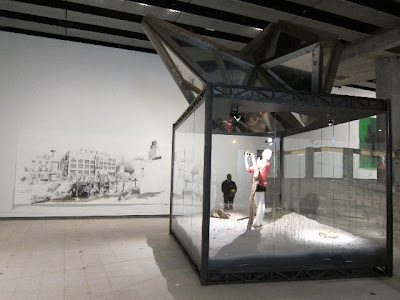
Keith Wilson's 'Zone 1' sculpture based on the shape of the mid section of the Piccadilly line

exhibition view

Charles Avery, drawings and scene inside glass box


Phoebe Unwin's paintings

The Maureen Paley corner, Wolfgang Tillmans' photograph and 'Truth Study Centre' and Maaike Schoorel's paintings (to the right)


photocopies on Wolfgang Tillman's 'Truth Study' Centre tables, Guatemala hole, homosexuals in Iran


Maaike Schoorel's almost invisible paintings


Gwendoline Christie, Princess Julia and the George and Dragon at Nathaniel Mellor's film 'Our House, Episode 2'

Olivia Plender's 'The Lost Works of Johan Riding', archive on a fictional filmmaker



Ian Kiaer, 'Melnikov Project'

Spartacus Chetwynd, 'The Folding House', performance stage

Karla Black's floating pink sculpture and Varda Caivano's paintings


Varda Caivano's paintings

Juliette Blightman, 'so a day is not really a day because each day is like having another day and they begin to have nothing', subtle intervention and lecture-performance loosely based on Fassbinder's 'Fear of Fear'

Sarah Lucas' 'Nuds' nylon tights sculptures and Becky Beasley's 'Korrrektur' series photographs

Harroon Mirza's sound sculpture with footage of Joy Division's Ian Curtis and his song 'She's Lost Control'

Christian Marclay's 'The Clock'




Simon Martin, seated Olmec figure from the Sainsbury Collection and 'Untitled (after Sol Le Witt)'

curators Lisa Le Feuvre and Tom Morton being interviewed...
Press Release:
British Art 7
In teh Days of the Comet
The British Art Show is widely recognised as the most ambitious and influential exhibition of contemporary British art. Organised by Hayward Touring, it takes place every five years and tours to four different cities across the UK. Now in its seventh incarnation, British Art Show 7 opens in Nottingham, and tours to the Hayward Gallery in London and galleries across the cities of Glasgow and Plymouth.
Curated by Lisa Le Feuvre and Tom Morton, the 39 selected artists have been chosen on the grounds of their significant contribution to contemporary art in the last five years. All artworks included have been produced since 2005 and encompass sculpture, painting, installation, drawing, photography, film, video and performance, with many artists creating new works especially for the exhibition.
The Curators write:
"British Art Show 7: In the Days of the Comet looks to art made in the period 2005–10, paying particular attention to the ways in which artists make use of histories – be they distant or proximate, longingly imagined or all too real – to illuminate our present moment. While current scientific theory posits that comets are nothing more than elliptically orbiting clumps of dust, ice and gas, utterly indifferent to our affairs, they remain powerful reminders of the way in which our species has attempted to understand experience through the measuring of time, the writing of history, the belief in cosmological influence, and the notion of a deterministic universe. The comet alludes here to the measuring of time, to historical recurrence, and – in the commonly counter-clockwise movements of these heavenly bodies around the sun – to pocket universes and parallel worlds. The comet is a sign mistaken for a wonder, be that cataclysm or rapture, and a figure of looping obsession. It is something that is always with us, no matter that it is sometimes far out of sight.
The subtitle of the seventh British Art Show is taken from H.G. Wells's 1906 novel In the Days of the Comet, set a century ago in 1910, the date of Halley's Comet's last-but-one apparition. The British socialist and science-fiction writer imagines the appearance of a comet over the United Kingdom, which releases a green gas that creates a ‘Great Change' in all mankind, turning it away from war and exploitation and towards rationalism and a heightened appreciation of beauty. Notably, this shift in understanding is achieved not through human agency, but through an ineffable alien force. What is significant about Wells's title, however, is that the ‘days' to which it refers are not only those of an enforced Utopian transformation, but the whole of recorded history. The comet's recurrent nature, and its orbiting of the same sun as the Earth, draws together the past, present and perhaps even the future too. Britain has always lived ‘in the days of the comet."
Lisa Le Feuvre & Tom Morton, 2010
http://www.britishartshow.co.uk














No comments:
Post a Comment